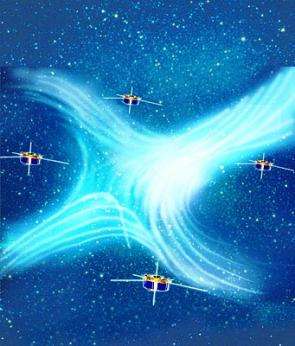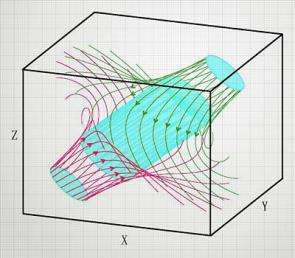Cluster hits the magnetic bull's-eye

ESA's spacecraft constellation Cluster has hit the magnetic bull's-eye. The four spacecraft surrounded a region within which the Earth's magnetic field was spontaneously reconfiguring itself.
This is the first time such an observation has been made and gives astronomers a unique insight into the physical process responsible for the most powerful explosions that can occur in the Solar System: the magnetic reconnection.
When looking at the static pattern of iron filings around a bar magnet, it is difficult to imagine how changeable and violent magnetic fields can be in other situations.
In space, different regions of magnetism behave somewhat like large magnetic bubbles, each containing electrified gas known as plasma. When the bubbles meet and are pushed together, their magnetic fields can break and reconnect, forming a more stable magnetic configuration. This reconnection of magnetic fields generates jets of particles and heats the plasma.
At the very heart of a reconnection event, there must be a three dimensional zone where the magnetic fields break and reconnect. Scientists call this region the null point but, until now, have never been able to positively identify one, as it requires at least four simultaneous points of measurements.

On 15 September 2001, the four Cluster spacecraft were passing behind the Earth. They were flying in a tetrahedral formation with separations between the spacecraft of over 1 000 kilometres. As they flew through the Earth's magnetotail, which stretches out behind the night-time side of our planet, they surrounded one of the suspected null points.
The data returned by the spacecraft have been extensively analysed by an international team of scientists led by Dr. C. Xiao from Chinese Academy of Sciences, Prof. Pu from Peking University, Prof. Wang from Dalian University of Technogy. Xiao and his colleagues used the Cluster data to deduce the three-dimensional structure and size of the null point, revealing a surprise.
The null point exists in an unexpected vortex structure about 500 kilometres across. "This characteristic size has never been reported before in observations, theory or simulations," say Xiao, Pu and Wang.
This result is a major achievement for the Cluster mission as it gives scientists their first look at the very heart of the reconnection process.
Throughout the Universe, magnetic reconnection is thought to be a fundamental process that drives many powerful phenomena, such as the jets of radiation seen escaping from distant black holes, and the powerful solar flares in our own Solar system that can release more energy than a billion atomic bombs.
On a smaller scale, reconnection at the dayside boundary of the Earth's magnetic field allows solar gas through, triggering a specific type of aurora called 'proton aurora'.
Understanding what sparks magnetic reconnection will also help scientists trying to harness nuclear fusion for energy production. In tokamak fusion reactors, spontaneous magnetic reconfigurations rob the process of its controllability. By understanding how magnetic fields reconnect, fusion scientists hope to be able to design better reactors that prevent this from taking place.
Having identified one null point, the team now hopes to score future bull's-eyes to compare nulls and see whether their first detection possessed a configuration that is rare or common.
The finding appear in Nature Physics, in an article titled "In situ evidence for the structure of the magnetic null in a 3D reconnection event in the Earth's magnetotail", by C.J. Xiao et al. (Vol 2, July 2006, pp 478. doi: 10.1038/nphys342).
Source: European Space Agency




















